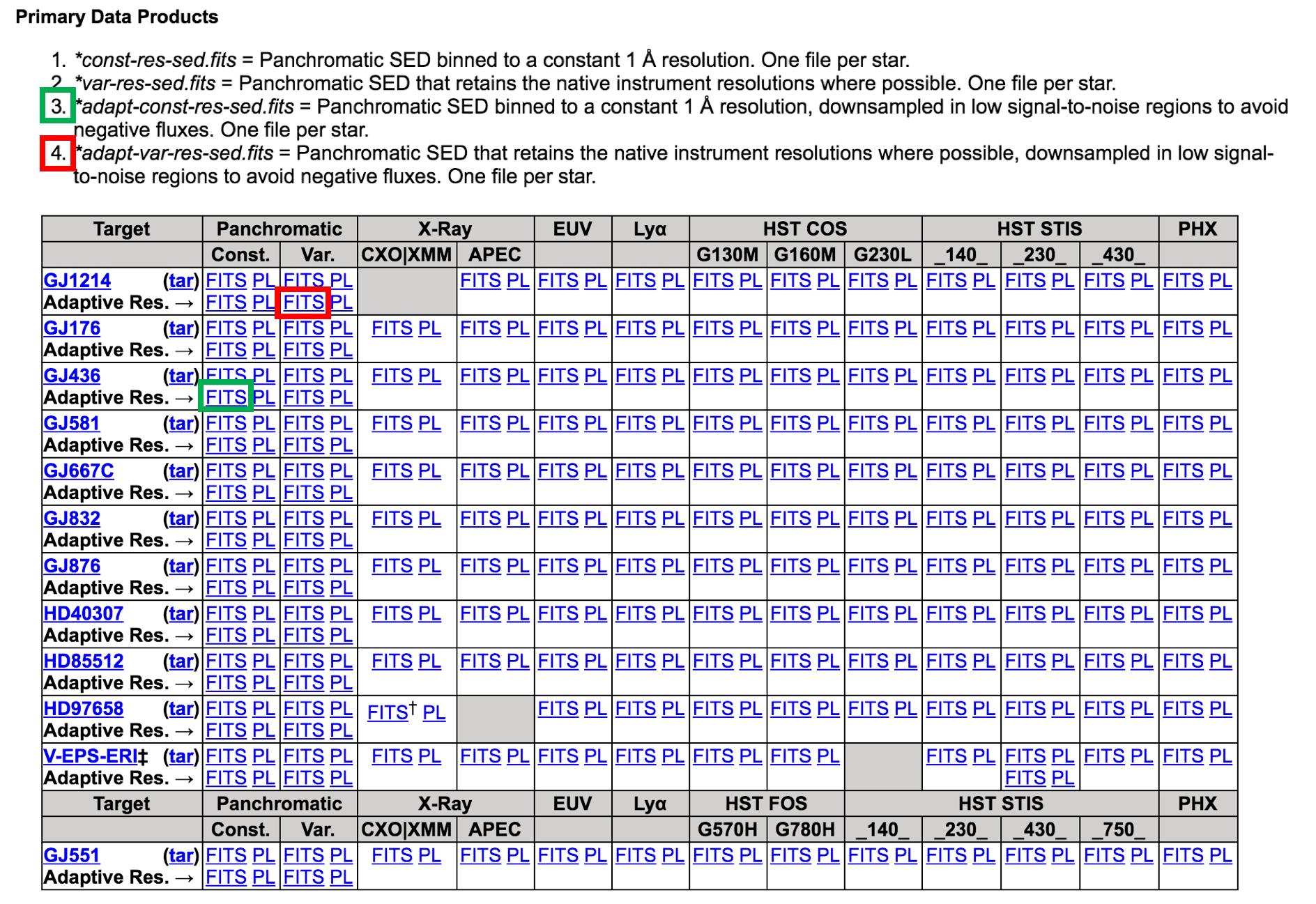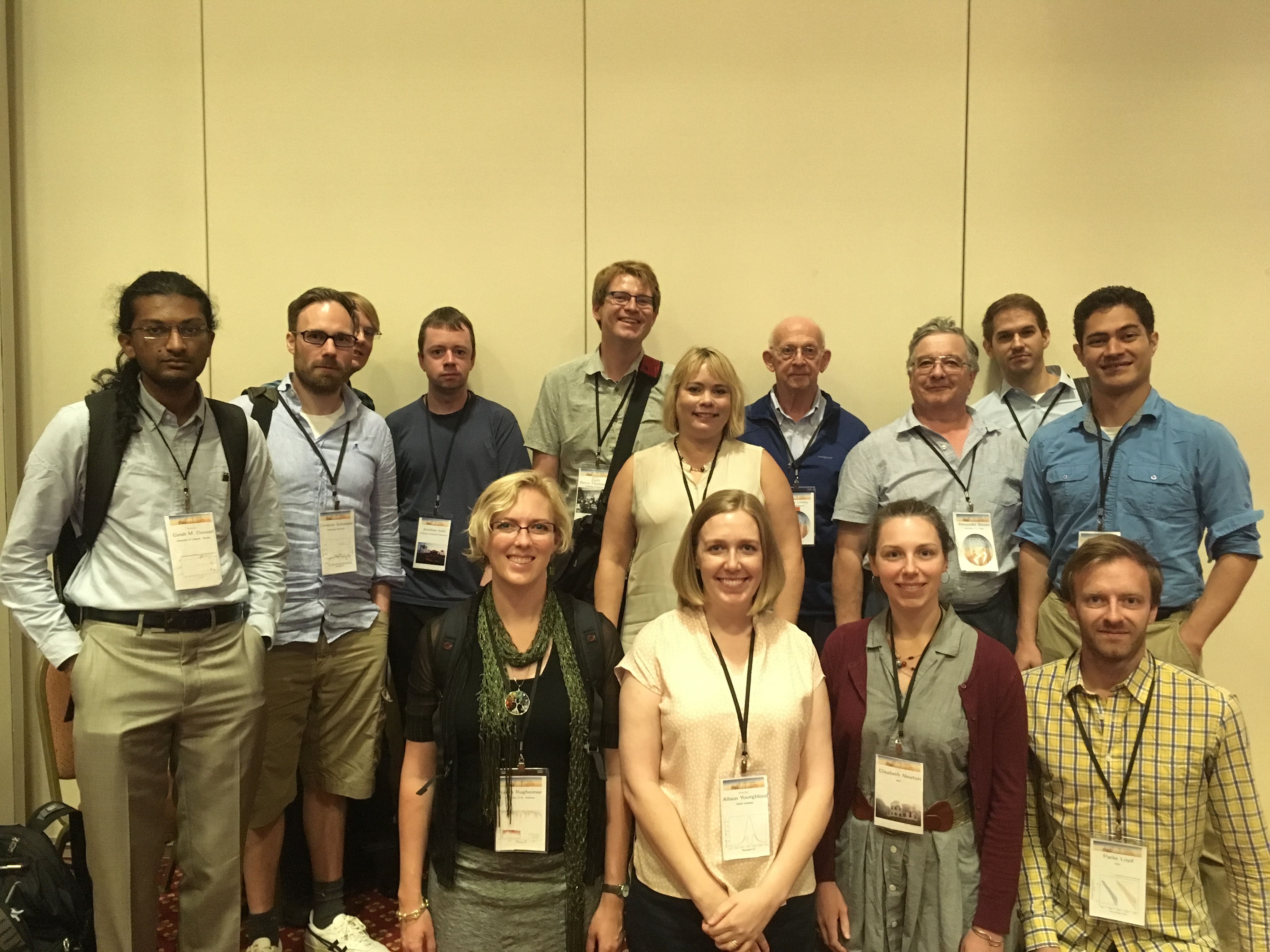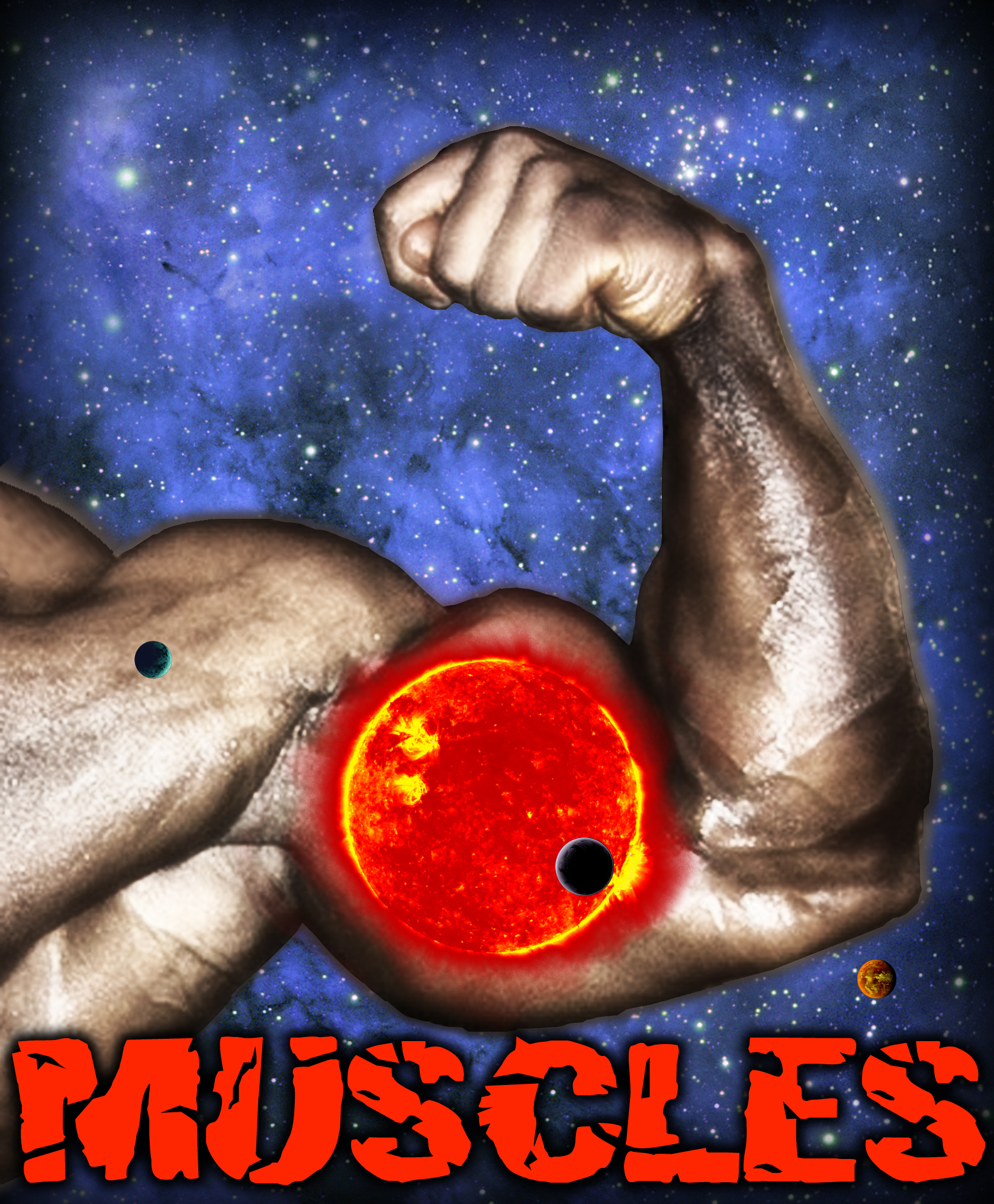
This screenshot from MAST shows example hyperlinks that users should use to download the full panchromatic SEDs. To download GJ 436's primary data product #3 in FITS format, select the link highlighted by the green box. To download GJ 1214's primary data product #4 in FITS format, select the link highlighted by the red box.
Reading in and plotting the downloaded data: The README file provides a full description of the data and should be read through by all users, but we summarize briefly how you can quickly read-in and plot an SED in Python and IDL.
This example is specifically for the file "hlsp_muscles_multi_multi_gj436_broadband_v10_adapt-const-res-sed.fits", which is highlighted in the green box in the figure.
Python:
from astropy.io import fits
import matplotlib.pyplot as plt
spec = fits.getdata('hlsp_muscles_multi_multi_gj436_broadband_v10_adapt-const-res-sed.fits',1)
plt.plot(spec['WAVELENGTH'],spec['FLUX'])
plt.xlabel('Wavelength (Angstroms)')
plt.ylabel('Flux Density (erg/cm^2/s^1/A^1)')
plt.show()
IDL:
data_436 = MRDFITS(path+'hlsp_muscles_multi_multi_gj436_broadband_v10_adapt-const-res-sed.fits',1,head_436)
wave = data_436.wavelength
flux = data_436.flux
error = data_436.error
plot,wave,flux,xs=1,ys=1,xr=[10,50000],yr=[0.001,10000]*1d-15,/ylog,/xlog,TITLE='GJ 436; MUSCLES Example',xtitle='Wavelength (Ang)',ytitle='Observed Flux Density (erg/cm2/s/Ang)',charsize=1.75
Papers describing the MUSCLES Treasury Survey:
- France et al. 2016. ApJ. "The MUSCLES Treasury Survey. I. Motivation and Overview" 820, 89
- Youngblood et al. 2016. ApJ. "The MUSCLES Treasury Survey. II. Intrinsic Lyα and Extreme Ultraviolet Spectra of K and M Dwarfs with Exoplanets" 824, 101
- Loyd et al. 2016. ApJ. "The MUSCLES Treasury Survey. III. X-ray to Infrared Spectra of 11 M and K Stars Hosting Planets" 824, 102
- Youngblood et al. 2017. ApJ. "The MUSCLES Treasury Survey. IV. Scaling Relations for Ultraviolet, Ca II K, and Energetic Particle Fluxes from M Dwarfs" 843, 31
- Loyd et al. 2018. Submitted to AAS Journals. "The MUSCLES Treasury Survey. V. FUV Flares on Active and Inactive M Dwarfs"
The Original MUSCLES Pilot Survey:
- France et al. 2012. ApJ. "Time-Resolved Ultraviolet Spectroscopy of the M-Dwarf GJ 876 Exoplanetary System" 750, L32
- France et al. 2013. ApJ. "The Ultraviolet Radiation Environment around M Dwarf Exoplanet Host Stars" 763, 149
Example papers that have utilized MUSCLES data products:
- Linsky et al. 2013. ApJ. "Computing Intrinsic Lyα Fluxes of F5 V to M5 V Stars" 766, 69
- Kulow et al. 2014. ApJ. "Lyα Transit Spectroscopy and the Neutral Hydrogen Tail of the Hot Neptune GJ 436b" 786, 132
- Linsky et al. 2014. ApJ. "The Intrinsic Extreme Ultraviolet Fluxes of F5 V TO M5 V Stars" 780, 61
- Tian et al. 2014. E&PSL. "High stellar FUV/NUV ratio and oxygen contents in the atmospheres of potentially habitable planets" 385, 22
- Domagal-Goldman et al. 2014. ApJ. "Abiotic Ozone and Oxygen in Atmospheres Similar to Prebiotic Earth" 792, 90
- Wordsworth et al. 2015. ApJ. "Atmospheric Heat Redistribution and Collapse on Tidally Locked Rocky Planets" 806, 180
- Gao et al. 2015. ApJ. "Stability of CO2 Atmospheres on Desiccated M Dwarf Exoplanets" 806, 249
- Rugheimer et al. 2015. ApJ. "Effect of UV Radiation on the Spectral Fingerprints of Earth-like Planets Orbiting M Stars" 809, 57
- Harman et al. 2015. ApJ. "Abiotic O2 Levels on Planets around F, G, K, and M Stars: Possible False Positives for Life?" 812, 137
- Schaefer et al. 2016. ApJ. "Predictions of the Atmospheric Composition of GJ 1132b" 829, 63
- Fontenla et al. 2016. ApJ. "Semi-Empirical Modeling of the Photosphere, Chromosphere, Transition Region, and Corona of the M-Dwarf Host Star GJ 832" 830, 154
- Loyd et al. 2017. ApJL. "Ultraviolet C II and Si III Transit Spectroscopy and Modeling of the Evaporating Atmosphere of GJ436b" 834, L2
- Airapetian et al. 2017. ApJL. "How Hospitable Are Space Weather Affected Habitable Zones? The Role of Ion Escape" 836, L3
- Ranjan et al. 2017. ApJ. "The Surface UV Environment on Planets Orbiting M-Dwarfs: Implications for Prebiotic Chemistry and the Need for Experimental Follow-Up" 843, 110
- Huang et al. 2017. ApJ. "A Model of the Hα and Na Transmission Spectrum of HD 189733b" 851, 150
- Oklopčić & Hirata 2018. ApJ Letters. "A New Window into Escaping Exoplanet Atmospheres: 10830 Å Line of Metastable Helium" 855, 11
- Wordsworth et al. 2018. AJ. "Redox evolution via gravitational differentiation on low mass planets: implications for biosignatures, water loss and habitability" 155, 195
- Cui et al. 2017. AsBio. "On the Growth and Detectability of Land Plants on Habitable Planets around M Dwarfs" 17, 1219
- Crossfield & Kriedberg 2017. AJ. "Trends in Atmospheric Properties of Neptune-Size Exoplanets" 154, 261
- Kawashima & Ikoma 2018. ApJ. "Theoretical transmission spectra of exoplanet atmospheres with hydrocarbon haze: Effect of creation, growth, and settling of haze particles. I. Model description and first results." 853, 7
- Lora et al. 2018. ApJ. "Atmospheric circulation, chemistry, and infrared spectra of Titan-like exoplanets around different stellar types" 853, 58
- Rugheimer & Kaltenegger 2018. ApJ. "Spectra of Earth-like Planets Through Geological Evolution Around FGKM Stars" 854, 19
- Meadows et al. 2018. AsBio. "The Habitability of Proxima Centauri b: Environmental States and Observational Discriminants" 18, 133
- Spake et al. 2018. Nature. "Helium in the eroding atmosphere of an exoplanet" 557, 68
- Rimmer et al. 2018. Science Advances. "The origin of RNA precursors on exoplanets" 4, 3302
The MUSCLES Team:
- Zachory K. Berta-Thompson, University of Colorado
- Alexander Brown, University of Colorado
- Andrea Buccino, Instituto De Astronomia Y Fisica Del Espacio
- James Davenport, Western Washington University
- Juan Fontenla, NW Research Associates
- Kevin France (PI Cycle 19 & 22), University of Colorado
- Cynthia Froning (PI Cycle 25), University of Texas
- Suzanne Hawley, University of Washington
- Renyu Hu, JPL/Caltech
- Jonathan Irwin, Harvard/CfA
- Lisa Kaltenegger, Cornell University
- Adam Kowalski, NSO/University of Colorado
- Jeffrey L. Linsky, University of Colorado
- R. O. Parke Loyd, Arizona State University
- Katie Melbourne, Yale University
- Pablo Mauas, Instituto De Astronomia Y Fisica Del Espacio
- Yamila Miguel, Universite de Nice
- Elisabeth R. Newton, MIT
- J. Sebastian Pineda, University of Colorado
- Seth Redfield, Wesleyan University
- Aki Roberge, NASA/GSFC
- Sarah Rugheimer, University of St. Andrews
- Christian Schneider, ESA/ESTEC
- John T. Stocke, University of Colorado
- Feng Tian, Tsinghua University
- Mariela Vieytes, Instituto De Astronomia Y Fisica Del Espacio
- Lucianne Walkowicz, Adler Planetarium
- Kolby Weisenburger, University of Washington
- David Wilson, University of Texas
- Brian Wood, Naval Research Laboratory
- Allison Youngblood, NASA/GSFC
Acknowledgement: If you download and use the MUSCLES spectra for scientific analysis, we request that you cite France et al. 2016 and include the following brief acknowledgement: "This work has made use of the MUSCLES Treasury Survey High-Level Science Products; doi:10.17909/T9DG6F."

The MUSCLES website is hosted by the
Center for Astrophysics and Space Astronomy,
University of Colorado. The MUSCLES logo was designed by Sarah LeVine.

